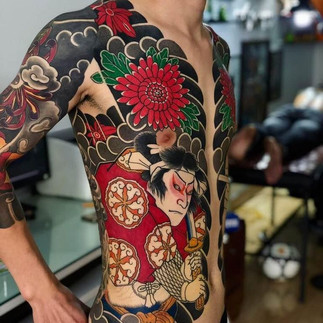What Does the Kaizen Tattoo Mean? Meaning, Where to Get It and Ideas [2025]
- Leonardo Pereira

- Aug 5
- 7 min read
Updated: Nov 10
Kaizen tattoos are popular body art. They symbolize personal growth and continuous improvement. The Japanese concept "Kaizen" (改善) has become a powerful emblem for self-development and transformation.
This guide explores the meaning, designs, and cultural significance of Kaizen tattoos. We will answer: "What Does the Kaizen Tattoo Mean?" and why it's a sought-after concept in tattoo culture.
Table of Contents
What You'll Discover in This Guide
This guide offers a concise overview of Kaizen tattoos.
It covers their symbolism, cultural context, and practical aspects. Gain insights to make an informed decision about this meaningful body art.
True Meaning: Understand "change for the better" and "continuous improvement."
Philosophy: Explore Kaizen's application in personal and professional life.
Symbolism: Learn diverse meanings, answering "What Does the Kaizen Tattoo Mean?"
Designs & Placement: Discover popular styles and ideal body locations.
Cultural Respect: Understand appropriation concerns.
Comparisons: See how Kaizen differs from other Japanese concepts.
The True Meaning of Kaizen
To understand what a Kaizen tattoo means, know its origins in Japanese culture. It's a fundamental worldview.
Linguistic Roots
"Kaizen" (改善) combines:
"kai" (改): "change" or "improvement"
"zen" (善): "good" or "better"
Together, they mean "change for the better" or "continuous improvement." This simple phrase holds deep philosophical significance, defining what a Kaizen tattoo means.
Philosophical Core
In traditional Japanese culture, Kaizen values gradual, consistent progress. It stems from Zen Buddhist principles of mindfulness and patience.
True mastery comes from small, incremental changes.
This aligns with "kodawari" (pursuit of perfection) and "shokunin kishitsu" (craftsman's spirit).
Beyond Business
Initially a post-WWII industrial concept (e.g., Toyota), Kaizen is now a personal philosophy. It applies to all life aspects: work, relationships, art, spiritual growth. Japanese language nuances emphasize process over final achievement.
Kaizen Philosophy: Beyond the Tattoo
The Kaizen philosophy extends beyond body art. It's a comprehensive approach to personal development.
Key Principles
Kaizen centers on five principles:
Continuous Improvement: Nothing is perfect; always seek betterment.
Small, Incremental Changes: Progress through manageable steps.
Eliminating Waste: Remove non-value-adding activities.
Everyone Involved: Improvement comes from all levels.
Standardization with Flexibility: Consistent processes, open to evolution.
Personal Growth
Kaizen offers a sustainable path for self-improvement. It emphasizes "the power of small" steps for lasting change, reducing intimidation.
Psychologically, small actions build habits, working with neurological realities.
Diverse Applications
Kaizen applies broadly:
Professional: Basis for Lean Management and Six Sigma, transforming industries.
Spiritual: Connects to mindfulness and Zen Buddhism, valuing process over outcome.
Environmental: Aligns with waste reduction and mindful resource use.
Relationships: Fosters healthy connections through small adjustments and collaboration.
Understanding these applications clarifies what a Kaizen tattoo means as a commitment to a holistic life philosophy.
Kaizen Tattoo Symbolism
Kaizen tattoos hold rich symbolic meanings. Interpretations vary based on personal context.
Core Interpretations
Personal Transformation: Represents an ongoing journey of self-improvement, acknowledging "works in progress."
Professional Achievement: Symbolizes commitment to excellence through consistent refinement.
Spiritual Growth: Connects to inner development, mindfulness, and personal evolution.
Resilience & Adaptability: Represents overcoming challenges and adapting to change.
Specific Contexts
Recovery: Aligns with "one day at a time" principles for sustainable healing.
Cultural Connection: Links to Japanese aesthetic principles and heritage.
Collective Improvement: Signifies commitment to community development and social change.
These interpretations show the versatility of Kaizen tattoos, defining what a Kaizen tattoo means to diverse individuals.
Popular Kaizen Tattoo Designs
Kaizen tattoo designs vary widely, reflecting personal aesthetics and interpretation.
Design Styles
Traditional Japanese Calligraphy: Authentic rendering of 改善 kanji in classic brushstroke styles (kaisho, gyosho, sousho)
Minimalist: Clean, simplified kanji, often fine-line or geometric, emphasizing essential forms
English Script: "Kaizen" in Latin alphabet, sometimes with phrases like "continuous improvement.
Geometric & Abstract: Deconstructed characters, spirals, or ascending patterns representing progress.
Integrated Elements
Designs often combine Kaizen with other symbols to enhance meaning:
Lotus flowers: Spiritual growth.
Phoenix: Transformation.
Mountains: Journey of improvement.
Waves: Constant change.
Bamboo: Strength and flexibility.
Color Symbolism: Black for tradition, red for passion, blue for wisdom.
Size: From micro (discreet) to large-scale (statement piece).
Temporal Elements: Visual patterns showing ongoing development.
Kaizen Tattoo Placement
Placement adds meaning to a Kaizen tattoo, influencing its personal expression.
Location Meanings
Wrist: Daily visual reminder, "hands-on" approach to improvement.
Forearm: More canvas, visible and symbolizes strength through effort.
Ribcage/Side: Private, intimate connection to core values.
Back/Shoulder: Large canvas for elaborate designs, symbolizes significant transformations.
Ankle/Foot: Grounding, represents improvement as a life foundation ("steps forward").
Neck/Behind-Ear: Flexible visibility, links to mindset and quiet, incremental change.
Sternum/Chest: "Close to the heart," signifies Kaizen as a core identity.
Finger/Hand: Highly visible daily reminder, connects to craftsmanship and ongoing development.
Kaizen vs. Other Japanese Concept Tattoos
Japanese philosophy offers other meaningful tattoo concepts. Understanding them clarifies what a Kaizen tattoo means in context.
Distinctions
Wabi-Sabi (侘寂): Embraces imperfection and impermanence, contrasting Kaizen's improvement focus.
Ikigai (生き甲斐): "Reason for being," addresses purpose (why) vs. Kaizen's process (how).
Shoshin (初心): "Beginner's mind," emphasizes open-mindedness vs. Kaizen's continuous progress.
Kintsugi (金継ぎ): Repairs broken pottery, highlighting beauty in damage vs. Kaizen's future enhancement.
Bushido (武士道): Samurai code, focuses on ethical character vs. Kaizen's methodology.
Mono no aware (物の哀れ): Appreciates transient beauty vs. Kaizen's forward-looking improvement.
Gaman (我慢): Enduring hardship with dignity vs. Kaizen's active improvement.
These concepts can be complementary, offering diverse perspectives on growth and life.
Who Should Consider a Kaizen Tattoo?
Kaizen tattoos resonate strongly with certain individuals, based on their values and life experiences.
Target Audiences
Personal Development Enthusiasts: Value continuous learning and self-reflection.
Recovery Community Members: Aligns with "one day at a time" and sustainable healing.
Entrepreneurs/Professionals: Represents commitment to excellence and innovation.
Athletes/Fitness Enthusiasts: Symbolizes consistent training and incremental physical development.
Creative Practitioners: Embodies mastery through ongoing skill refinement.
Mindfulness/Spiritual Seekers: Connects to inner development and conscious living.
Perfectionists in Recovery: Offers a healthier path by valuing incremental progress over perfection.
Life Transition Navigators: Provides grounding and focus during periods of change.
The Kaizen tattoo's meaning is deeply personal, emerging from one's connection to the philosophy.
Cultural Appropriation Considerations
Approaching Kaizen tattoos with respect is crucial, especially for non-Japanese individuals.
Respectful Approach
Appreciation vs. Appropriation: Understand the concept's meaning beyond aesthetics. Respect its cultural context.
Research Responsibility: Learn its history and contemporary use from diverse sources.
Language Accuracy: Verify kanji with experts to ensure correct representation.
Design Context Sensitivity: Avoid inappropriate combinations of symbols.
Personal Connection Authenticity: Ensure the tattoo genuinely reflects your personal growth.
Japanese Perspective Inclusion: Consult with Japanese individuals or artists when possible.
Context Communication: When sharing, acknowledge its Japanese origins and personal meaning.
Frequently Asked Questions About Kaizen Tattoos
What does Kaizen mean in Japanese?
Kaizen (改善) combines "kai" (change/improvement) and "zen" (good/better), meaning "change for the better" or "continuous improvement." It's a fundamental Japanese philosophy valuing gradual, consistent progress in all life aspects, emphasizing process over outcome.
Is a Kaizen tattoo cultural appropriation?
A Kaizen tattoo can be appreciation, not appropriation, if approached thoughtfully. This involves genuine understanding of its meaning and cultural context, accurate kanji representation, and an authentic personal connection to the philosophy, rather than purely aesthetic or trendy adoption. Consulting Japanese experts is advised.
How are Kaizen tattoos written in Japanese?
Kaizen tattoos use the kanji characters 改善. Styles vary: Kaisho (楷書) (standard, formal), Gyosho (行書) (semi-cursive, flowing), and Sousho (草書) (highly stylized, cursive). Minimalist and abstract renderings are also popular. Proper stroke order and structure are essential for authenticity.
Where is the best placement for a Kaizen tattoo?
Ideal placement depends on personal meaning and visibility. Popular options include the wrist or forearm (daily reminder, visible), ribcage or side (private, intimate), back or shoulder (large canvas for elaborate designs), or ankle/foot (grounding, "steps forward" symbolism). Each location adds a unique layer of meaning.
What are some good design ideas for Kaizen tattoos?
Design ideas range from traditional calligraphy and minimalist kanji to integrated imagery (lotus, phoenix, mountains, waves, bamboo) and geometric/abstract interpretations. Color symbolism can add depth (black for tradition, red for passion). Accompanying phrases like "small steps" can personalize the meaning.
What does a Kaizen tattoo say about someone?
A Kaizen tattoo suggests a growth mindset, process orientation, patience, persistence, and self-reflection. It indicates someone who values consistent growth, embraces continuous improvement, and finds meaning in the journey rather than just outcomes. It also implies cultural appreciation and a thoughtful approach to symbolism.
Conclusion: Embracing Continuous Improvement Through Kaizen Tattoos
Kaizen tattoos symbolize personal growth and transformation.
More than aesthetics, they embody a life philosophy valuing patient progress and embracing imperfection.
This exploration clarifies what a Kaizen tattoo means for those who choose it.
Kaizen tattoos are powerful due to their versatility.
They offer practical wisdom across life contexts: recovery, professional excellence, creative mastery, or daily self-improvement.
The Kaizen philosophy balances acceptance of reality with gentle improvement.
For a Kaizen tattoo, understanding its cultural context, ensuring accurate representation, and having an authentic connection are key.
Work with skilled artists for meaningful symbols.
A Kaizen tattoo is a permanent reminder: improvement is a journey, not a destination. In a world chasing instant success, Kaizen offers a refreshing alternative: the power of small, consistent steps.
Whether calligraphic or minimalist, your Kaizen tattoo serves as a personal touchstone and public declaration.
May it remind you that small, consistent steps lead to remarkable journeys, and the path of improvement holds immense value.
改善 – Change for the better, one day at a time.
























































Comments